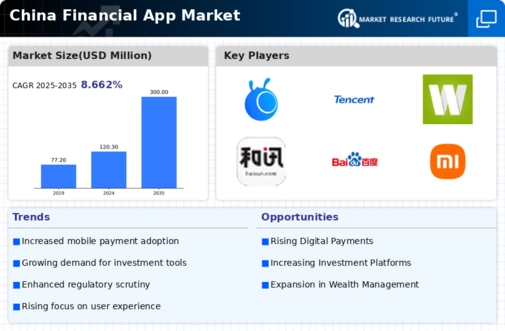Rising Smartphone Penetration
The financial app market in China is experiencing a notable surge due to the increasing penetration of smartphones. As of 2025, approximately 1.2 billion mobile phone users exist in China, with over 90% owning smartphones. This widespread access to mobile technology facilitates the adoption of financial applications, allowing users to manage their finances conveniently. The financial app market benefits from this trend, as more individuals engage with digital financial services. Furthermore, the integration of advanced features such as biometric authentication and AI-driven insights enhances user experience, potentially driving further growth. The convenience of mobile banking and investment apps is likely to attract a broader demographic, including younger users who prefer managing their finances on-the-go. This trend suggests a promising future for the financial app market in China, as smartphone usage continues to rise.
Growing Demand for Investment Apps
The financial app market in China is witnessing a growing demand for investment applications, driven by an increasing interest in personal finance and wealth management. Recent data indicates that around 30% of Chinese consumers actively use investment apps to manage their portfolios. This trend is particularly pronounced among millennials and Gen Z, who are more inclined to seek digital solutions for investment opportunities. The financial app market is adapting to this demand by offering user-friendly interfaces, educational resources, and real-time market data. As more individuals seek to take control of their financial futures, the proliferation of investment apps is likely to continue. This shift not only empowers users but also contributes to the overall growth of the financial app market, as it attracts new users and encourages existing ones to explore additional features.
Increased Focus on Financial Literacy
The financial app market in China is benefiting from a heightened focus on financial literacy among consumers. As awareness of personal finance management grows, individuals are increasingly seeking tools that can help them make informed financial decisions. Educational initiatives, often supported by both the government and private sector, aim to improve financial literacy rates, which currently stand at around 40% among the adult population. This emphasis on education is likely to drive demand for financial apps that offer budgeting tools, investment guidance, and personalized financial advice. The financial app market is responding by integrating educational content into their platforms, thereby enhancing user engagement and retention. As financial literacy improves, users may become more confident in utilizing financial apps, potentially leading to increased adoption and usage.
Government Support for Fintech Innovation
The financial app market in China is significantly influenced by government initiatives aimed at fostering fintech innovation. The Chinese government has implemented various policies to encourage the development of digital financial services, including tax incentives and funding for startups. In 2025, the government allocated approximately $1 billion to support fintech research and development. This proactive approach not only stimulates competition within the financial app market but also enhances the overall ecosystem by promoting collaboration between traditional financial institutions and tech companies. As a result, consumers benefit from a wider array of innovative financial solutions tailored to their needs. The financial app market is likely to see increased investment and technological advancements, which could lead to the emergence of new players and services, further enriching the market landscape.
Emergence of AI and Machine Learning Technologies
The financial app market in China is increasingly influenced by the emergence of AI and machine learning technologies. These advancements enable financial apps to offer personalized experiences, predictive analytics, and enhanced security features. As of 2025, approximately 25% of financial apps in China incorporate AI-driven functionalities, which allow for tailored recommendations based on user behavior and preferences. This trend not only improves user satisfaction but also enhances the overall efficiency of financial services. The financial app market is likely to see further integration of these technologies, as they provide a competitive edge in a rapidly evolving landscape. Moreover, the ability to analyze vast amounts of data in real-time could lead to more informed decision-making for users, thereby fostering greater trust and reliance on financial applications.

















Leave a Comment